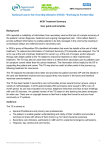Download Treatment Record Summary – User Guide
Transcript
Treatment Summary Summary of learning, Revised Template and User Guide Introduction The document introduces the revised Treatment Summary (TS) for use at the end of initial treatment for cancer. It may also be useful at other points in the journey. It provides a set of standards and core components along with some ‘top tips’ from NHS test communities that have tested its use over the past year. Background GPs reported the multiplicity of information from secondary care but the lack of a simple summary of the patients’ cancer diagnosis treatment and on going management plan. Clinic letters failed to provide sufficient information to enable patients to be fully managed in the community resulting in unnecessary delays and referrals back to secondary care In spring 2009 a group of Macmillan GP advisors identified information that would be helpful at the end of first line treatment. A template was designed and subsequently tested in 11 NHS test communities across several tumour groups using a variety of methodologies. Approximately 250 summaries were issued to GPs over a 6 month period. Its use was evaluated via surveys, telephone interviews and face to face meetings with over 50 clinicians. An updated version of the TS based on this learning has been developed for wider use (see Appendix 1). There are no copyright issues so feel free to adapt the format to suit your local community or IT systems however please keep the key headings, GP READ Codes and NCSI acknowledgements. Audience: The TS is aimed at: General Practitioners and primary care professionals The patient to enable greater understanding and clarity of their condition and provide a summary to share with health care professionals and others of their choice e.g. for travel insurance purposes Secondary care clinicians. Particularly useful in A&E for unplanned emergency admissions Summary of evaluation findings The TS has been positively received in both primary and secondary care. 80% of GPs found the summary useful or very useful and on the content made constructive suggestions for improvement. Over 50% felt it would make a difference to the way they manage patients and 90% wanted its use to continue. The majority of hospital clinicians recognised the value of summarising what could be months of treatment and holistic care into a concise summary. Some voiced concerns about the complexity of content and length of time it took to complete whilst others found it had little impact on time once they became familiar with it... One clinician felt that ‘it made us document and communicate better’ another thought it to be ‘excellent’. . Presentation and completion methodology There are three presentation styles organisations may wish to consider, the standard form/template, a letter that follows the template headings or an electronic solution. Most test communities used the template and boxes in the format provided, others converted to a letter template to improve ease of use by secretarial staff. Two sites created electronic versions using an access database with a series of drop down menus to aid the speed of completion. One site transmitted the TS electronically to the GP, others printed and posted. One consultant completed the TS in place of the clinic letter and provided a copy for the patient to take with them when leaving the clinic. Recommended Practice The following standards support the use of the TS The completed TS should be sent to both the patient (having agreed to be copied into all correspondence) and the GP within 2 weeks of the appointment at the end of treatment TS updates should be generated at other key points e.g. following recurrence, further treatment or a transition to end of life care Effort should be made to complete all sections. Information about prognosis should be completely sensitively and in accordance with the patient wishes. The TS should not replace detailed care plan based on an assessment of need Members of the MDT involved in the patients care should contribute to the completion of the TS GPs should be encouraged to use the TS in conjunction with Cancer Care Review and to highlight any necessary monitoring or reviews required Revised Treatment Summary templates The TS has been amended since testing to remove less useful information Appendix 1 provides the revised TS template with updated GP READ codes. Appendix 2 provides a user guide with rational for data inclusion and an indication of the essential and desirable fields required should local re-design of the form be preferred. Appendix 3 provides an example template with prompt notes Appendix 4 provides the same information in a letter template Hints and Tips for implementation: The following hints and tips have been provided by the NHS Improvement test communities: Engage administrative staff early in change process and encourage them to suggest the best way to implement locally Keep primary leads informed of planned changes to documentation and be receptive to further changes they may suggest. Avoid handwriting the TS - type wherever possible Provide a laminated prompt list in clinic for clinicians to use as they dictate To encourage uptake, encourage testing for say 5 patients and then review content and process. Ensure process review occurs. If redesigning template beware of removing fields as they may be useful to others Create template letter with headings to enable easier typing Use the TS in place of a clinic letter on one clinic occasion and retain a copy in the case notes Ensure that the medical records department are aware of the additional proforma and aware of the appropriate place in the notes for filing (this will avoid them being removed from the patient’s records inappropriately). Colour code the form/letter to denote sections for doctor and CNS to complete To save time some sections can be completed by others prior to the appointment with the remaining sections completed by the doctor at the time Attach the template prompt list to the front of case notes prior to the patient being seen in clinic as a reminder to complete on this visit Pre-fill the boxes where possible such as for common signs and symptoms of recurrence, treatment toxicities For complex tumour group consider separate list of signs and symptoms, what to do and key contacts if help required (examples available on request to NHS Improvement Survivorship Team) If template set up as electronic database, add common signs symptoms and medications as drop down menus Share testing and experience with other colleagues to encourage wider testing and spread of the use of the TS. Provide GP READ codes attached to each letter or issue separately Feedback To provide further feedback and comment please contact: [email protected] Dr Rosie Loftus – GP Macmillan Lead [email protected] or Noeline Young [email protected] Date issued: December 2010 Appendix 1 Treatment Summary Insert GP Contact Details Insert Trust Logo and Address Dear Dr X Re: Add in patient name, address, date of birth and record number Your patient has now completed their initial treatment for cancer and a summary of their diagnosis, treatment and ongoing management plan are outlined below. The patient has a copy of this summary. Diagnosis: Date of Diagnosis: Organ/Staging Local/Distant Summary of Treatment and relevant dates: Treatment Aim: Possible treatment toxicities and / or late effects: Advise entry onto primary care palliative or supportive care register Yes / No . Alert Symptoms that require referral back to specialist team: DS1500 application completed Yes/No Prescription exemption arranged Yes/No Contacts for re referrals or queries: In Hours: Out of hours: Referrals made to other services: (delete) District Nurse AHP Secondary Care Ongoing Management Plan: (tests, appointments Social Worker etc) Dietician Clinical Nurse Specialist Psychologist Benefits/Advice Service Other Required GP actions in addition to GP Cancer Care Review e.g. ongoing medication, osteoporosis and cardiac screening. Summary of information to the patient about their cancer and future progress: Additional information relating to lifestyle and support needs Completing Doctor: National Cancer Survivorship Initiative Signature: Date: GP READ CODES – CANCER (For GP Use only) System 1 Diagnosis: Lung Malignant Tumour Carcinoma of Prostate Bowel Intestine Large Bowel Female Malignant Neoplasia Male Malignant Neoplasia Histology/Staging/Grade: Histology Abnormal Tumour grade Dukes/Gleason tumour stage Recurrent tumour Local Tumour Spread Mets from 1° Treatment Palliative Radiotherapy Curative Radiotherapy Chemotherapy Radiotherapy Treatment Aim: Curative procedure Palliative procedure Treatment toxicities/late effects: Osteoporotic # Osteoporosis Infection Ongoing Management Plan Follow up arranged (<1yr) Follow up arranged (>1yr) No FU Referral PRN Referrals made to other services: District Nurse Social Worker Nurse Specialist SALT Actions required by the GP Tumour marker monitoring PSA Osteoporosis monitoring Referral for specialist opinion Advised to apply for free prescriptions Medication: New medication started by specialist Medication changed by specialist Advice to GP to start medication Advice to GP to stop medication Information to patient: DS1500 form claim Benefits counselling Cancer information offered 5 digit codes All other systems Diagnosis Lung Cancer Prostate Cancer Malignant neoplasm of Rectum Malignant neoplasm of Colon Cancer female breast 4 digit codes Tumour staging Gleason Recurrence of tumour .4M .4MO .4M6 Carcinoma metastases .BB13 5149 XalpH x71bL Xa851 Tumour palliation Radiotherapy Chemotherapy .5149 .7M371 .8BAD Xallm XaiL3 Curative procedure Palliative procedure .8BJO .8BJ1 Xa1TO XaELC Xa9ua Osteoporosis .1409 Follow up arranged .8H8 No follow up arranged .8HA Osteoporosis monitoring .66A Entitled to free prescriptions .6616r XEOhn 8B316 XaKbF XaJC2 Medication given .8BC2 XaCDx 6743 XalmL DS1500 .9eb5 XaOKG X78Y6 X78gK X78gN B34 B35 4K14 X7A6m XaOLF XaOR3 X7818 XaFr 8H8. XaL. 8HA1 8HAZ .B222 .B46 .B14 .B13 .B34 XaBsn XaBsr XaAgq XaBT6 Xalqg Xalqh XalSd Xalst 9D05 Treatment Summary User Guide Appendix 2 Field Rationale for inclusion Diagnosis Important for the GP and patient to know type of cancer and location of cancer and the likely source of secondary recurrence. Information about staging and spread provides insight into prognosis and risk of recurrence To understand length of time patient has known diagnosis and time period between referral from primary care and diagnosis to learn where delays can be minimised in future. Important data to monitor treatment outcomes in relation to survivorship. Helps plan date of GP Cancer Care Review. To understand the range and order of modality treatment, understand the likely sequence of treatment effects. Essential to inform future treatment choice if further disease occurs. Important information for patients wishing to take out insurance or a mortgage. To understand whether treatment intended is curative, palliative or for symptom relief as this will help GPs to understand aims of treatment, refer back to secondary care or other services appropriately. Also help GPs to anticipate future care needs. Patients undergoing cancer treatments may be more prone to toxicity and late effects of treatment such as osteoporosis or heart disease. Inclusion of risks in this summary triggers the entering of the patient onto routine GP surveillance (QOF related). Signs and symptoms addressed earlier may improve quality of life and treatment outcomes from side effects or late consequences of treatment. Inclusion of suggested or preferred treatment associated with toxicities and late effects can be initiated without referral back to the specialist. Raises awareness of common late effects and reduces delays to further investigation and treatment. This may also impact on survival rates as symptoms are picked up sooner Organ Staging/local or distant spread (Grade) Date of Diagnosis Summary of Treatment and relevant dates Treatment Aim Possible treatment toxicities and or late effects of treatment Essential or Desirable E D D E E E Advise entry onto palliative or supportive care register DS 1500 status and prescription exemption Alert symptoms that require referral back to specialist team Contact for re referrals or queries in and out of hours Secondary Care On-going Management plan Referrals to other services Inclusion of the patient on the palliative care register ensures that the primary health care teams are made aware that a patient is nearing end of life and that increased input maybe required to support patient and carers. The register is shared with all relevant OOH doctors, ambulance service, community district nursing teams, Macmillan support team, social care, hospice as appropriate. Patients can then receive the appropriate support, information and benefits in a timely manner. If no DS 1500 completed the GP will be prompted to arrange. Also ensures that exemption charges are waived for any cancer treatment - an entitlement for all patients with a diagnosis of cancer This should include only those symptoms where immediate re-referral to secondary care specialist is required e.g. acute breathlessness requiring a pleural tap, as opposed to the expected side effects of treatment that can be managed by the GP or community team. Improved information to the patient will also enable better patient choice especially related to End of Life Care. Confirms contact details for the patient or GP for advice on care or treatment or to arrange urgent review. The out of hours contact could be a ward, the acute oncology team or relevant on call team Include any planned outpatient reviews and surveillance tests dates (or approximated timescales). This provides a framework for GPs. If indicated, further tests can be scheduled prior to the further outpatient visits. Patients will be better informed about follow up plans and what to expect. It is reassuring to patients and carers to see the planned care, surveillance and support, they then know what to expect and when. Helps avoid duplication of referral if the patient visits the GP between appointments and is unsure of who is involved in their care. Particularly useful in respect social care referrals and whether the patient is known to other agencies. Can help to reinforce the importance of attending appointments with other agencies. Useful to also include details related to third sector support and centres such as Maggie’s if available. D D E E E D Required GP actions including medication etc Cancer Care Review Summary of information given to the patient about their cancer and future prognosis Additional Information given including issues relating to lifestyle and support needs READ Codes To provide clarity on the expectation of GPs in respect of the patients ongoing care and how they can support them. Also provides prompts e.g. to add patients to routine screening programmes to help mitigate late effects of treatment. Patients will be more empowered to approach GPs if they require further advice and support. Can give specific request to GPs to ensure continuity of care and avoid ambiguity. Provides GPs with guidance and advice on which drugs if any need stopping and when and whether any adjusting between follow up appointments or following discharge. May avoid inappropriate prescriptions, overdose or misuse. Particularly important if the GP is going to continue to prescribe long term i.e. endocrine manipulation. Patients will also know what to expect from GP. Inclusion of this reminder helps ensure the patient is entered onto the register and that they are formally reviewed by the GP within 6 months of diagnosis. This is a requirement for QOF points within all general practices Sharing information on what has been discussed with the patient and their carer improves the quality and openness of the discussion that the GP can have with the patient. To confirm which lifestyle advice has been given or signposted and details of local support groups and psychosocial support, complementary therapies, returning to work advice etc GP READ codes are similar to hospital HRG codes and used to identify diagnosis, tests and treatments. Both are complex systems and require manual input. Inclusion of the READ codes in the TS prompts and encourages GPs to accurately code patients. This helps improve patient safety in terms of surveillance, disease tracking and audit. It is the responsibility of the GPs to assign the appropriate codes and enter on their systems. Note Codes may differ depending on GP IT system in use E D E* D D Treatment Summary Example Appendix 3 Dear Dr Jones Re: John Smith, 3 Park Road, Doncaster DN4 DEF DoB: 10.10.10 NHS No: 123456 Your patient has now completed their initial treatment for cancer and a summary of their diagnosis; treatment and ongoing management plan are outlined below. The patient has a copy of this summary. Diagnosis: Date of Diagnosis: Colorectal Cancer 10 Feb 2010 th Organ/Staging – Dukes T2 Local/Distant – N0 Summary of Treatment and relevant dates: Treatment Aim: Surgery – Resection (March 10) and reversal of stoma (Sept 10) Radiotherapy - May – June 2010 Possible treatment toxicities and / or late effects: Curative Advise entry onto primary care palliative or supportive care register Diarrhoea following pelvic radiotherapy No . DS1500 application completed - No Prescription Charge exemption arranged - Yes Alert Symptoms that require referral back to specialist team: Diarrhoea for more than 2 weeks not relieved by loperamide/codeine Blood or mucus per rectum Further change in bowel function Abdominal pain that persists for longer than 4 weeks and does not respond to simple analgesia Secondary Care Ongoing Management Plan: (tests, appointments etc) Contacts for re referrals or queries: In Hours: 01234 567890 (CNS team) Out of hours: 01234 987654 (oncology ward) Referrals made to other services: Community Dietician Benefits/Advice Service Next OP Review - Jan 2011 CEA next due in Jan 2011 then annually until 2015 CT scan (abdo and chest) next due Sept 2011 Colonoscopy repeat next due Sept 2015 Required GP actions in addition to GP Cancer Care Review e.g. ongoing medication, osteoporosis and cardiac screening Please review dose of XXXXX in two months if symptoms of XXXX resolved reduce to 4mg daily Summary of information given to the patient about their cancer and future progress: Patient and wife informed that the cancer in his colon was non invasive and that he has received surgery and radiotherapy with curative intent. He is aware however that it may recur in the future and we have briefly discussed the further treatment available should this be required. He is fully aware of the symptoms of recurrence and what to do should any occur. Additional information relating to lifestyle and support needs Patient advised to quit smoking and referred to smoking cessation clinic Patient keen to join local colorectal support group and plans to attend next session in November Completing Doctor: Charles Goodenough National Cancer Survivorship Initiative Signature: Date: 30.10.10 Appendix 4 Template in letter format Date: XXXXXXXX Dear Dr Enter GP name XXXX Re: Your patient has now completed their initial treatment for cancer and a summary of their diagnosis; treatment and ongoing management plan are outlined below. The patient has a copy of this summary. Diagnosis: Date of diagnosis: Organ/Staging: Local/Distant Summary of Treatment and relevant dates: Treatment Aim: Possible treatment toxicities and / or late effects: Alert symptoms that require referral back to specialist team: Secondary Care Ongoing Management Plan: (tests, appointments etc) Other service referrals made: eg Dietician, Psychologist, Social Worker Required GP actions in addition to Cancer Care Review (e.g. Medication, osteoporosis/cardiac screening) Summary of information given to the patient about their cancer and prognosis: Additional information including issues related to lifestyle and support needs: Advise on entry to primary care palliative or supportive care register: (Yes/No) DS1500 application completed: (Yes/No/N/A) Prescription charge exemption arranged: (yes or No) Contact for re-referral or any queries; In hours Out of hours: Yours sincerely Consultant xxxxxxxx CC: Insert patient name
















